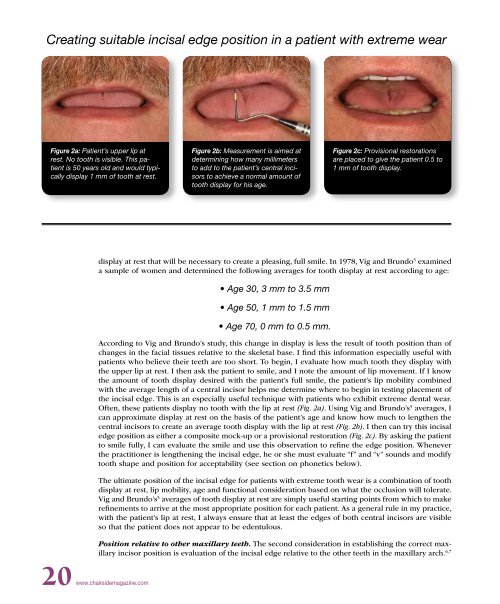PDF Version - Glidewell Dental Labs
PDF Version - Glidewell Dental Labs
PDF Version - Glidewell Dental Labs
You also want an ePaper? Increase the reach of your titles
YUMPU automatically turns print PDFs into web optimized ePapers that Google loves.
Creating suitable incisal edge position in a patient with extreme wear<br />
Figure 2a: Patient’s upper lip at<br />
rest. No tooth is visible. This patient<br />
is 50 years old and would typically<br />
display 1 mm of tooth at rest.<br />
Figure 2b: Measurement is aimed at<br />
determining how many millimeters<br />
to add to the patient’s central incisors<br />
to achieve a normal amount of<br />
tooth display for his age.<br />
Figure 2c: Provisional restorations<br />
are placed to give the patient 0.5 to<br />
1 mm of tooth display.<br />
display at rest that will be necessary to create a pleasing, full smile. In 1978, Vig and Brundo 5 examined<br />
a sample of women and determined the following averages for tooth display at rest according to age:<br />
• Age 30, 3 mm to 3.5 mm<br />
• Age 50, 1 mm to 1.5 mm<br />
• Age 70, 0 mm to 0.5 mm.<br />
According to Vig and Brundo’s study, this change in display is less the result of tooth position than of<br />
changes in the facial tissues relative to the skeletal base. I find this information especially useful with<br />
patients who believe their teeth are too short. To begin, I evaluate how much tooth they display with<br />
the upper lip at rest. I then ask the patient to smile, and I note the amount of lip movement. If I know<br />
the amount of tooth display desired with the patient’s full smile, the patient’s lip mobility combined<br />
with the average length of a central incisor helps me determine where to begin in testing placement of<br />
the incisal edge. This is an especially useful technique with patients who exhibit extreme dental wear.<br />
Often, these patients display no tooth with the lip at rest (Fig. 2a). Using Vig and Brundo’s 5 averages, I<br />
can approximate display at rest on the basis of the patient’s age and know how much to lengthen the<br />
central incisors to create an average tooth display with the lip at rest (Fig. 2b). I then can try this incisal<br />
edge position as either a composite mock-up or a provisional restoration (Fig. 2c). By asking the patient<br />
to smile fully, I can evaluate the smile and use this observation to refine the edge position. Whenever<br />
the practitioner is lengthening the incisal edge, he or she must evaluate “f” and “v” sounds and modify<br />
tooth shape and position for acceptability (see section on phonetics below).<br />
The ultimate position of the incisal edge for patients with extreme tooth wear is a combination of tooth<br />
display at rest, lip mobility, age and functional consideration based on what the occlusion will tolerate.<br />
Vig and Brundo’s 5 averages of tooth display at rest are simply useful starting points from which to make<br />
refinements to arrive at the most appropriate position for each patient. As a general rule in my practice,<br />
with the patient’s lip at rest, I always ensure that at least the edges of both central incisors are visible<br />
so that the patient does not appear to be edentulous.<br />
Position relative to other maxillary teeth. The second consideration in establishing the correct maxillary<br />
incisor position is evaluation of the incisal edge relative to the other teeth in the maxillary arch. 6,7<br />
20 www.chairsidemagazine.com

















